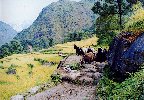Pace of Life in the Annapurna Region
The Marsyangdi river originates in lake Tilicho, five thousand metres high
in the Annapurna range. It gathers quite a momentum as it races down through the
steep valley it has cut in these impressive, and still quite young, mountains. The gorge
cut by the Marsyangdi is so steep and the ground it cuts through so rocky that no
wheeled vehicles can be used on the rough hewn paths. Modern road development has only reached
the lowlands of Nepal and in the valleys, the 'roads' are mostly hand constructed, roughy
level paths. Long stone staircases cope with the sudden changes in terrain.
The persistent pounding
 the river gives to the cliff edges result in landslides, further deteriorating the mountain
paths and providing constant employment to the local teams of path builders. The main routes
along the valley floor have migrated over the years as the locals have made new paths
through landslides in an attemps to maintain trade upriver. Without recourse to wheels,
everyone in the Marsyangdi valley walks. If you sit by the roadside for a few hours you will
see groups of grinning schoolchildren, porters carrying loads heavier than their own
bodyweight, sometimes whole families passing by on unknown errands.
the river gives to the cliff edges result in landslides, further deteriorating the mountain
paths and providing constant employment to the local teams of path builders. The main routes
along the valley floor have migrated over the years as the locals have made new paths
through landslides in an attemps to maintain trade upriver. Without recourse to wheels,
everyone in the Marsyangdi valley walks. If you sit by the roadside for a few hours you will
see groups of grinning schoolchildren, porters carrying loads heavier than their own
bodyweight, sometimes whole families passing by on unknown errands.
 Herdsmen are the slowest as the cajole their troops of mules, goats or buffalo along
the often treacherous way. The mules are a rare concession to
non-human transport. Each mule carries a little more than a human porter, but they are slower. The distance a
man can cover in four days will take a mule six. Wherever the valley widens out, like
in Tal, or in Manang, you will see people riding ponys, and there are even occasional mountain
bikes in Manang. These are localised anomalies however and the pace of life in the valley is ruled by the
pace of a walking population.
Herdsmen are the slowest as the cajole their troops of mules, goats or buffalo along
the often treacherous way. The mules are a rare concession to
non-human transport. Each mule carries a little more than a human porter, but they are slower. The distance a
man can cover in four days will take a mule six. Wherever the valley widens out, like
in Tal, or in Manang, you will see people riding ponys, and there are even occasional mountain
bikes in Manang. These are localised anomalies however and the pace of life in the valley is ruled by the
pace of a walking population.


|